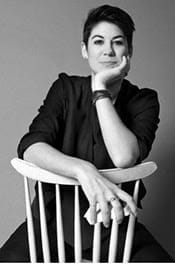Dr. Leyla Acaroglu on How to Change the World
12/10/20

What’s Your Superpower?
Some may think it takes a miracle or magic to make change. The truth is that everyone has the ability to make it happen because everyone has the power to think differently about the future. “Being able to imagine an alternative future helps us build the tools and processes to get there,” Dr. Acaroglu pointed out. She also suggested that learning to love problems instead of fearing or avoiding them helps in finding solutions. So, it’s really a person’s thought process that can be considered their superpower. You don’t need super strength or the ability to fly to help save the world. You have your brain. Now use it for good.
Redesigning Your Path
Armed with the knowledge that we all can create positive change, Dr. Acaroglu showed us how easy it is to put a plan into action. It all started with the remote control. At 19, she was studying design and decided she wanted to solve problems. She didn’t understand the design of a television remote—too many buttons, no instructions, and a plastic case. This snowballed into frustration about why companies were still designing plastic products when there is such a plastic waste crisis.
Dr. Acaroglu transformed her frustration into a new career path. She went back to school and became a sociologist with a focus on sustainability. Then she combined her two passions and started building a career in sustainable design. She explained how everyone is a “citizen designer” by the way we shape the future through our actions. Her goal is to activate positive change by “designing tools to help people think differently about how the world works.” And this is when Disruptive Design was born.
If You Design it, Change Will Come
At 25, Dr. Acaroglu started a company that designed educational tools on sustainable products. She also put her plans into practice by redesigning abandoned newspaper stands in Melbourne, Australia to sell locally made products. Why? “Showing people how new ideas can exist really helps make change.” And it worked. Other artisans saw how easy it was to set up their own spaces and quickly followed suit. The result? A resurgence of art throughout the city and microeconomic opportunities for all.
Dr. Acaroglu wanted to share her vision of solving complex problems in creative ways, so she started a school. Well, The Unschool of Disruptive Design, to be exact. This experimental knowledge lab is a place where people from around the world share ideas on sustainability and how to design a better future.
Change: Can’t Stop, Won’t Stop
In all of life’s uncertainties, one thing is for sure: change is constant. We see it in the growth of all living things, advances in medicine and technology, passing fads, environmental ebb and flow, and throughout every industry. Because of this fact, there are a lot of opportunities to participate in change. Here’s where Dr. Acaroglu teaches us about “activating your agency.” This is when we go from not seeing our power to influence change to expanding our sphere of influence and finally becoming passionate about helping to do good work. “We all change the world anyway, through our actions, so why not change it to make it a better place.”
If you’re still asking yourself, how? “Creativity and innovation are two of the most important tools” to facilitate change. Dr. Acaroglu reiterated her belief in “being willing and ready to take on problems and love them” and added we also must be willing to question the world. We have the power to redesign our own brain. If we can shift our mindset to think differently about how we’re interacting with the environment in our daily lives, we can significantly improve our ecological footprint and live more sustainably. And this is only the beginning.
The future is made today. Not only do we have to change the world to make it a better place for us to live, but we must build a better tomorrow for future generations. Leyla encouraged us to try to find the positive and passionate aspects of our daily lives, even in seemingly boring tasks. Sometimes the effects of what we’re doing aren't always obvious—positive or negative. But if we pay more attention to how we’re affecting change, we have the power to also become Champions of the Earth.
Share on social media